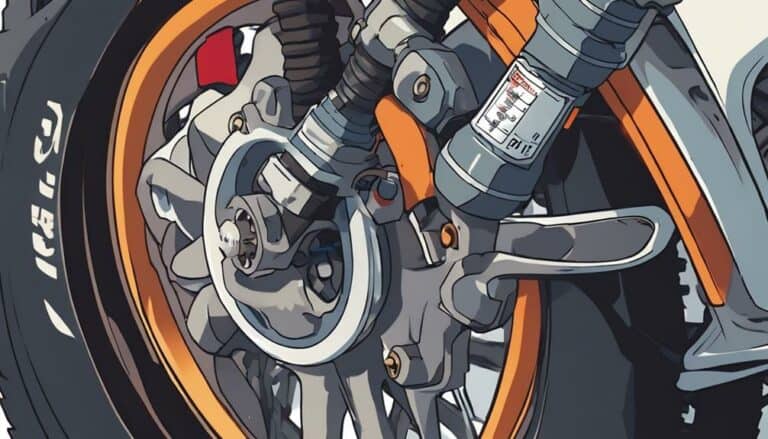Ever wondered what psi your dirt bike tires should be at?
The correct tire pressure can greatly impact your riding experience and performance on various terrains.
Finding the ideal psi is vital for maintaining control, traction, and avoiding unnecessary wear and tear on your tires.
If you're looking to optimize your dirt biking adventures, understanding the importance of tire pressure and how to adjust it accordingly is key.
Key Takeaways
- Adjust tire pressure based on terrain type and rider weight for optimal performance.
- Lower pressures for softer terrains, higher for rocky trails to enhance grip.
- Regular monitoring essential to prevent stability issues and punctures.
- Experiment with pressures to find the right balance for traction and puncture resistance.
Factors Affecting Optimal Tire Pressure
When determining the best tire pressure for dirt bike tires, various factors must be considered to guarantee peak performance and safety. Terrain type is a critical element influencing the ideal tire pressure. For softer terrains such as mud or sand, lower tire pressures are generally recommended to increase traction and floatation. In contrast, on harder surfaces like rocky trails, higher tire pressures are preferred to prevent pinch flats and enhance stability.
Rider weight is another vital factor in determining the right tire pressure. Heavier riders exert more force on the tires, requiring higher pressures to support the weight adequately and prevent excessive sidewall flex. Conversely, lighter riders may benefit from slightly lower pressures to improve grip and shock absorption.
Knob size also plays a role in the recommended tire pressure level. Tires with larger knobs typically perform better at lower pressures as the knobs can deform and conform to the terrain, enhancing traction. On the other hand, tires with smaller knobs may require higher pressures to maintain stability and prevent the knobs from folding over during aggressive riding.
Advantages of Adjusting Tire Pressure
Adjusting tire pressure on your dirt bike provides distinct advantages that directly impact your performance and control on varying terrains. By fine-tuning the tire pressure to suit specific riding conditions, you can experience the following benefits:
- Maximized Grip: Adjusting tire pressure can maximize grip for different terrains, enhancing traction and control. Higher tire pressure offers more speed and protection, suitable for hard surfaces like clay and hardpack.
- Improved Traction: Lower tire pressure improves grip and traction, making it ideal for loose and soft terrains. This adjustment allows for better handling and stability on challenging surfaces.
- Enhanced Performance: Maximized tire pressure caters to rider weight, bike type, and terrain, maximizing performance. Small changes in tire pressure can have a significant impact on overall riding experience and safety, ensuring you get the most out of your dirt bike adventures.
Adjusting tire pressure enables you to adapt to varying terrains effectively, enhancing your riding experience.
Signs of Incorrect Tire Pressure
Maintaining the accurate tire pressure is important as it directly impacts your dirt bike's traction, handling, and overall performance. Signs of incorrect tire pressure can manifest in various ways.
If your tire pressure is too low, you may experience reduced stability and control while riding. Underinflated tires are more prone to pinch flats, where the tire gets pinched between the rim and an obstacle, leading to flats.
On the other hand, overinflated tires can result in a harsh ride, decreased grip on the trail, and uneven tire wear. Monitoring your tire pressure regularly is critical to prevent these issues.
Strategies to Prevent Tire Punctures
To enhance your dirt bike's puncture resistance, strategic tire pressure management is essential. Here are three effective strategies to prevent tire punctures:
- Consider Using a Tubliss System:
The Tubliss system replaces conventional inner tubes, providing a high-pressure rim lock combined with a low-pressure tube. This innovative system enhances the tire's stability and allows for lower tire pressures without the risk of pinch flats.
- Utilize Mousse Inserts:
Mousse inserts are foam-based inserts that replace traditional inner tubes. They offer superior puncture resistance by eliminating the risk of pinch flats altogether. While they can be a bit more expensive, mousse inserts provide excellent protection against punctures in extreme riding conditions.
- Find the Right Tire Pressure Balance:
Experiment with different tire pressures to find the most suitable balance between traction, performance, and puncture resistance. Understanding how tire pressure affects puncture likelihood is vital in determining the most fitting pressure for your riding style and terrain. Gradually adjusting and maintaining the tire pressure at the ideal level can considerably reduce the risk of punctures, ensuring a safer and more enjoyable ride.
Additional Considerations for Tire Pressure
Considering the varying demands of different terrains, determining the appropriate tire pressure for your dirt bike is essential for optimizing performance and safety. When tackling hard pack surfaces, such as rocky or compacted dirt trails, adjusting your tire pressure can greatly enhance your riding experience.
For hard pack terrains, slightly higher pressure in both the front and rear tires is recommended. The increased pressure helps the tires maintain better shape and grip on these firm surfaces, providing stability and control as you navigate through challenging conditions.
For the front tire, a pressure range of 12-15 psi is generally suitable for hard pack terrains, while the rear tire may benefit from a slightly higher pressure range of 14-18 psi. These adjustments can improve traction, reduce the risk of punctures, and enhance overall performance on hard pack surfaces. Remember, regular monitoring and fine-tuning of tire pressure based on the specific terrain you'll be riding on are important for achieving best results.
Conclusion
In summary, maintaining the ideal tire pressure for your dirt bike is essential for maximizing performance and handling on various terrains.
By regularly adjusting tire pressure based on factors like terrain and rider weight, you can guarantee a smooth and efficient ride.
Remember, just like a well-tuned engine, properly inflated tires are vital for peak performance on the track or trail.
Keep those tires pumped up and conquer the dirt with confidence!

